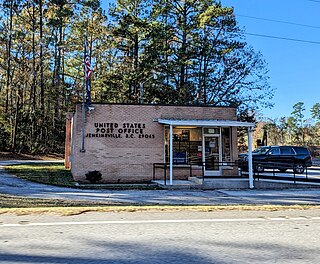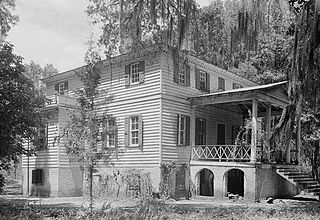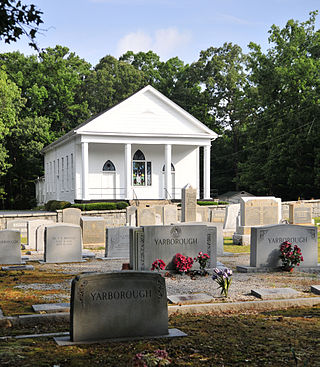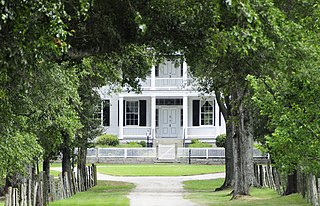
Winnsboro is a town in Fairfield County, South Carolina, United States. The population was 3,550 at the 2010 census. The population was 3,215 at the 2020 census, a population decrease of approximately 9.5% for the same 10 year period. It is the county seat of Fairfield County. Winnsboro is part of the Columbia, South Carolina metropolitan Area as well as a suburb of Columbia.

Jenkinsville is an incorporated town in western Fairfield County, South Carolina, United States, between the Broad and the Little rivers. It is located east of Monticello Reservoir and is near the Virgil C. Summer Nuclear Generating Station. Also in the area is the Kincaid-Anderson House and quarry. The town was incorporated in 2008. Jenkinsville's population at the 2010 census was 46, making it South Carolina's second smallest town.

Old Brick Church, which is also known as Ebenezer Associate Reformed Presbyterian (ARP) Church or First Associate Reformed Presbyterian Church is a church built in 1788 about 4 mi (6 km) north of Jenkinsville on SC 213 in Fairfield County, South Carolina. It was named to the National Register of Historic Places on August 19, 1971. It is one of the few 18th-century churches surviving in the South Carolina midlands.

Fairfield Plantation, also known as the Lynch House is a plantation about 5 mi (8 km) east of McClellanville in Charleston County, South Carolina. It is adjacent to the Wedge Plantation and just north of Harrietta Plantation. The plantation house was built around 1730. It is located just off US Highway 17 near the Santee River. It was named to the National Register of Historic Places on September 18, 1975.
Glenn House may refer to:

Little River Baptist Church is a historic Southern Baptist church located near Jenkinsville, Fairfield County, South Carolina. USA. It was built about 1845, and is a one-story, frame meeting house plan church. The church is a rectangular clapboard structure of Greek Revival design with Gothic Revival details in the front facade. The front gabled roof is supported by four octagonal columns on a raised platform. In the early 1950s, a wing was added to provide Sunday School rooms and kitchen facilities.

High Point is a historic home located near Jenkinsville, Fairfield County, South Carolina. The original section was built about 1800, and is a two-story, five-bay, frame farmhouse with later expansions. A two-story rear ell was built about 1870. It features a one-story, shed-roofed porch across the front façade supported by square posts. Also on the property are the contributing family cemetery, a frame smoke house, and a frame barn.

Kincaid-Anderson House, also known as Fairfield, is a historic home located near Jenkinsville, Fairfield County, South Carolina. It was built about 1774, and is a two-story, brick Georgian style dwelling. It has a hipped roof and sits on a fieldstone foundation. It has small brick side wings that were added in a 1920s restoration. Also on the property is a two-story brick and frame work house that has been converted into a guesthouse. It was the home of James Kincaid, who was one of the first purchasers of cotton in the South Carolina upcountry and was possibly involved in the early development of a cotton gin.
Mayfair is a historic home located near Jenkinsville, Fairfield County, South Carolina. It was built about 1824, and is a two-story, weatherboarded Federal style frame residence with a hipped roof. The front façade features a central, two-story, polygonal pedimented portico. According to local tradition, Mayfair was the home of Burrell B. Cook, a moderately wealthy planter, who served in the Twenty-eighth General Assembly of South Carolina from 1828 to 1829.
Hunter House is a historic home located near Ridgeway, Fairfield County, South Carolina. It was built about 1820, and is a 1+1⁄2-story, L-shaped Federal style weatherboarded building on a raised brick basement. It has a gable roof and exterior end chimneys. The five-bay façade features a pedimented porch sheltering the three central bays.
Mount Hope is a historic home located near Ridgeway, Fairfield County, South Carolina. It was built about 1836, and is a 1+1⁄2-story, vernacular weatherboarded building on a raised brick basement. It has a gable roof and three pedimented dormers. Also on the property are a frame smoke house and a tenant house. It was the home of Dr. John Peyre Thomas, a prominent physician and amateur scientist.

Valencia is a historic plantation house located near Ridgeway, Fairfield County, South Carolina. It was built in 1834, and is a large two-story frame house on a brick pier foundation. The house features a hipped roof, two mammoth chimneys, and a broad one-story piazza with unique elliptical arches. Valencia was built by Edward Gendron Palmer, a leader in civic, political, and religious life of Ridgeway and Fairfield County.

Albion is a historic plantation house located near Blackstock, Fairfield County, South Carolina. It was built about 1840 by a wealthy planter named Alexander Douglas.
Bob Lemmon House is a historic farmhouse located near Winnsboro, Fairfield County, South Carolina. It was built about 1850, and is a two-story, frame I-house. It has a gable roof, a single pile, central hall plan, and rear shed room additions. The façade features a two-tiered pedimented portico with four wooden Tuscan order columns. The property also includes a shed and a barn, both of frame construction sheathed in weatherboard.

Old Stone House is a historic home located near Winnsboro, Fairfield County, South Carolina. It was built in 1784, and is a two-story, side-gable roofed, stone building, with a double-pile floor plan and stone end chimneys. The façade has a central door with a massive stone lintel flanked by single four-over-four windows with stone lintels. It was built by Samuel Gladney and in 1870 it was purchased by the Lebanon Presbyterian Church for use as a parsonage.

The Oaks is a historic plantation house located near Winnsboro, Fairfield County, South Carolina in the Piedmont region. It was built in 1835 by Richard Hallum, and is a large, two-story, weatherboarded frame residence with a gable-end roof. The front façade features a central, two-tiered pedimented portico supported by four simple wooden columns. From 1856 the property was owned by John Montgomery Lemmon and his descendants. Considered a moderately wealthy planter, in 1860 he owned 19 slaves and his entire plantation was worth $10,000.

Rural Point, also known as Robertson House and Doty House, is a historic home and garden located at Winnsboro, Fairfield County, South Carolina. It was built in 1852, and is a 1+1⁄2-story, 12 bay, Greek Revival style frame dwelling over a high basement. The façade features a gable-roofed porch which is supported by four square columns. The property features a semi-formal garden said to have been designed by John Grimke Drayton, noted landscape architect of Magnolia Gardens in Charleston, South Carolina. Also on the property is a typical southern planter's office of white clapboard. It was built by William Ross Robertson, probate judge and commissioner of equity of Fairfield County who served in South Carolina House of Representatives and as a member of the Secession Convention.

Vaughn's Stage Coach Stop is a historic stagecoach stop located near Ridgeway, Fairfield County, South Carolina. It was built about 1820, and is a two-story, weatherboarded frame, gable-roofed residence with a double-pile and central hall floor plan. The building sits on a foundation of stone piers, has end chimneys, rear shed rooms, and a left rear addition. The façade features a one-story, shed-roofed porch with a plain wooden balustrade supported by six slender wooden posts.

Dr. Walter Brice House and Office is a historic plantation house and office located near Winnsboro, Fairfield County, South Carolina. It was built about 1840, and is a two-story, weatherboarded frame, L-shaped Greek Revival style dwelling. It features a two-tiered, pedimented front verandah supported by four wooden pillars. The Dr. Walter Brice Office is a 10-foot-by-12-foot weatherboarded frame building with a metal gable roof. Dr. Walter Brice was a prominent Fairfield County planter and physician before the American Civil War.

Furman Institution Faculty Residence is a historic residential building located near Winnsboro, Fairfield County, South Carolina. It was built about 1837, and is a two-story, brick building with a hipped roof and end chimneys. It has a single story, hip roofed front porch and a kitchen extension. The building serves as a visible reminder of the early history of Furman University and its brief establishment in Fairfield County.



















